Nash Thomas
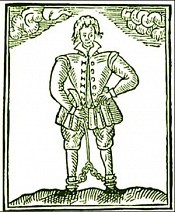
Thomas Nashe (November 1567 – c. 1601) was an English Elizabethan pamphleteer, poet and satirist. He was the son of the minister William Nashe and his wife Margaret (née Witchingham). Little is known with certainty of Nashe's life. He was baptized in Lowestoft, Suffolk, where his father was curate. The family moved to West Harling, near Thetford in 1573 after Nashe's father was awarded the living there at the church of All Saints. Around 1581 Thomas went up to St John's College, Cambridge as a sizar, gaining his bachelor's degree in 1586.[1] From references in his own polemics and those of others, he does not seem to have proceeded Master of Arts there. Most of his biographers agree that he left his college about summer 1588, as his name appears on a list of students due to attend philosophy lectures in that year. His reasons for leaving are unclear; his father may have died the previous year, but Richard Lichfield maliciously reported that Nashe had fled possible expulsion for his role in Terminus et non terminus, one of the raucous student theatricals popular at the time. Some years later, William Covell wrote in Polimanteia that Cambridge "has been unkind to the one [ie, Nashe] to wean him before his time." Nashe himself claimed that he could have become a fellow had he wished (in Have With You to Saffron-Walden). Then he moved to London and started his literary career in earnest. The remaining decade of his life was dominated by two concerns: finding an adequate patron and participating in controversies, most famously with Gabriel and Richard Harvey. He arrived in London with his one exercise in euphuism, The Anatomy of Absurdity. His first appearance in print was, however, his preface to Robert Greene's Menaphon, which offers a brief definition of art and overview of contemporary literature. After this (and the publication of Anatomy) he was drawn into the Martin Marprelate controversy on the side of the bishops. As with the other writers in the controversy, his share is difficult to determine. He was formerly credited with the three "pasquil" tracts of 1589-1590, which were included in R. B. McKerrow's standard edition of Nashe's works: however McKerrow himself later argued strongly against their being by Nashe. The anti-Martinist An Almond for a Parrot (1590), ostensibly credited to one "Cutbert Curry-knave," is now universally recognized as Nashe's work, although its author humorously claims, in its dedication to the comedian William Kempe, to have met Harlequin in Bergamo while returning from a trip to Venice in the summer of 1589. However, there is no evidence Nashe had either time or means to go abroad, and he never subsequently refers to having visited Venice elsewhere in his work. In 1590, he contributed a preface to an unlicensed edition of Philip Sidney's Astrophil and Stella, but the edition was called in, and the authorized second edition removed Nashe's work. At some time in the early 1590s Nashe produced an erotic poem, The Choice of Valentines, possibly for the private circle of Ferdinando Stanley, 5th Earl of Derby (then known as Lord Strange). This circulated only in manuscript. It describes the visit of a young man named 'Tomalin' to the brothel where his girlfriend Frances ('Frankie') is employed. Having paid ten gold pieces for her favours, Tomalin is embarrassed to find that merely lifting her skirts makes him lose his erection. She perseveres in arousing him however and they make love, but to her disappointment he has an orgasm before her. Frankie then decides to take matters into her own hands: hence the informal title by which the poem was known, Nashe's Dildo. It was sharply criticized for its obscenity by contemporary authors Joseph Hall and John Davies of Hereford, though Nashe had tried to pre-empt criticism by placing it in the tradition of classical erotica: "Yet Ovid's wanton muse did not offend". His friendship with Greene drew Nashe into the Harvey controversy. In 1590, Richard's The Lamb of God complained of the anti-Martinist pamphleteers in general, including a side-swipe at the Menaphon preface. Two years later, Greene's A Quip for an Upstart Courtier contained a passage on "rope makers" that clearly refers to the Harveys (whose father made ropes). The passage, which was removed from subsequent editions, may have been Nashe's. After Harvey mocked Greene's death in Four Letters, Nashe wrote Strange News (1593). Nashe attempted to apologize in the preface to Christ's Tears Over Jerusalem (1593), but the appearance of Pierce's Supererogation shortly after offended Nashe anew. He replied with Have With You to Saffron-Walden (1596), with a possibly sardonic dedication to Richard Lichfield, a barber of Cambridge. Harvey did not publish a reply, but Lichfield answered in a tract called "The Trimming of Thomas Nash," (1597). This pamphlet also contained a crude woodcut portrait of Nashe, shown as a man disreputably dressed and in fetters. Alongside this running dispute, Nashe produced his more famous works. While staying in the household of Archbishop John Whitgift at Croydon in October 1592 he wrote an entertainment called Summer's Last Will and Testament, a "shew" with some resemblance to a masque. In brief, the plot describes the death of Summer, who, feeling himself to be dying, reviews the performance of his former servants and eventually passes the crown on to Autumn. The play was published in 1600. In 1593 Nashe published Christ's Tears Over Jerusalem, a pamphlet dedicated to Lady Elizabeth Carey. Despite the work's apparently devotional nature it contained satirical material which gave offence to the London civic authorities and Nashe was briefly imprisoned in Newgate. The intervention of Lady Elizabeth's husband Sir George Carey gained his release. He remained in London apart from periodic visits to the countryside to avoid the plague - a fear reflected in the play Summers last will and Testament, written in the autumn of 1592. William Sommers, whose comments frame the play, was Henry VIII's jester. It includes the famous lyric: In 1597, following the suppression of The Isle of Dogs (co-written with Ben Jonson), Jonson was jailed, but Nashe was able to escape to the country. He remained for some time in Great Yarmouth before returning to London. He was alive in 1599, when his last known work, Nashes Lenten Stuffe, was published, and dead by 1601, when he was memorialized in a Latin verse in Affaniae by Charles Fitzgeoffrey. He was featured in Thomas Dekker's News from Hell and referred to in the anonymous Parnassus plays, of which the latter provides this epitaph: He is also credited with the erotic poem The Choice of Valentines and his name appears on the title page of Christopher Marlowe's Dido, Queen of Carthage, though there is uncertainty as to what Nashe's contribution was. Some editions of this play, still extant in the 18th century but now unfortunately lost, contained memorial verses on Marlowe by Nashe, who was his friend.
do you like this author?
What readers are saying
What do you think? Write your own comment on this book!
write a commentWhat readers are saying
What do you think? Write your own comment on this author!
write a commentBook list

The Vnfortunate Traveller,or The Life Of Jack WiltonWith An Essay On The Life And Writings Of Thomas Nash By Edmund Gosse
Series:
Unknown
Year:
Unknown
Raiting:
5/5
Show more
add to favoritesadd In favorites

The Choise of ValentinesOr the Merie Ballad of Nash His Dildo
Series:
Unknown
Year:
Unknown
Raiting:
4/5
Show more
add to favoritesadd In favorites

pap with a hatchet being a reply to martin mar prelate re printed from the o
Series:
Unknown
Year:
Unknown
Raiting:
3/5
Show more
add to favoritesadd In favorites
Book list

The Vnfortunate Traveller,or The Life Of Jack WiltonWith An Essay On The Life And Writings Of Thomas Nash By Edmund Gosse
Series:
Unknown
Year:
Unknown
Raiting:
5/5
Show more
add to favoritesadd In favorites

The Choise of ValentinesOr the Merie Ballad of Nash His Dildo
Series:
Unknown
Year:
Unknown
Raiting:
4/5
Show more
add to favoritesadd In favorites

pap with a hatchet being a reply to martin mar prelate re printed from the o
Series:
Unknown
Year:
Unknown
Raiting:
3/5
Show more
add to favoritesadd In favorites
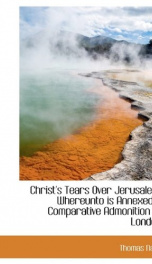
christs tears over jerusalem whereunto is annexed a comparative admonition to
Series:
Unknown
Year:
Unknown
Raiting:
4.5/5
Show more
add to favoritesadd In favorites
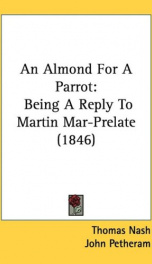
an almond for a parrot being a reply to martin mar prelate
Series:
Unknown
Year:
Unknown
Raiting:
4/5
Reprinted From The Black Letter Edition, With An Introduction And Notes.
Show more
add to favoritesadd In favorites
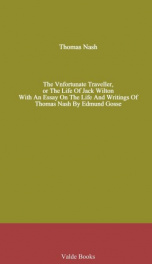
The Vnfortunate Traveller, or The Life Of Jack Wilton
Series:
Unknown
Year:
Unknown
Raiting:
4.5/5
Commentator: Edmund Gosse --This text refers to an alternate Paperback edition.
Show more
add to favoritesadd In favorites
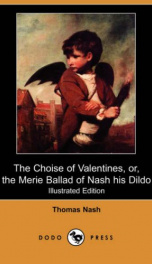
The Choise of Valentines
Series:
Unknown
Year:
Unknown
Raiting:
4.5/5
Thomas Nash/Nashe (1567-1600) was an English Elizabethan pamphleteer, poet and satirist. Nash applied his energetic prose style to many of the most contentious issues of his day, careering through a life that was as brief as it was memorable.
Show more
add to favoritesadd In favorites
What readers are saying
What do you think? Write your own comment on this author!
write a commentif you like Nash Thomas try:
readers also enjoyed
What readers are saying
What do you think? Write your own comment on this author!
write a commentGenre
if you like Nash Thomas try:
readers also enjoyed
Do you want to exchange books? It’s EASY!
Get registered and find other users who want to give their favourite books to good hands!

